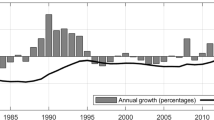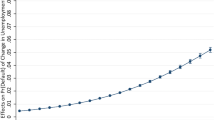Abstract
This study examines the transmission of the cost-of-funds rates, domestically and internationally, to owner-occupied housing interest rates at the bank level for the period 2002(7)–2015(12) in Australia. Three main issues, cross-sectional dependence, parameter heterogeneity, and asymmetry, have been considered using the linear and nonlinear common-factor Augmented Mean Group estimators. Significant unobservable coefficients in all estimates ascertain that unobserved common factors arising from both national and global shocks have a significant influence on mortgage rate transmission. The results of sizable heterogeneity and asymmetry, found in all estimates while controlling for cross-sectional correlations, highlight the substantial effect of the foreign-funds rate on long-run mortgage price setting. We find a closer connection between mortgage interest rates and international funding cost; we have also confirmed a declining transmission of the policy rate after the 2008 global financial crisis.


Similar content being viewed by others
Notes
The main advantages of the AMG model are discussed in Sect. 4.4 because of the space limitation of Introduction.
Owner-occupied loans indicate the value of housing loans to Australian households for the construction or purchase of dwellings for owner occupation; revolving credit or redraw facilities are originally approved for the purpose of predominantly owner-occupied housing (APRA 2017).
The 3-month BBSW, which represents the midpoint of the nationally observed best bid and best offer for AFMA Prime Bank Eligible Securities, including bank accepted bills and negotiable certificates of deposit, is used to provide reference interest rates for the pricing and revaluation of Australian dollar derivatives and debt securities.
This model is based on the markup pricing contribution of Rousseas (1985).
References
Allen J, McVanel D (2009) Price movements in the Canadian residential mortgage market. Bank of Canada Working Paper No. 2009-13
Allen MT, Rutherford RC, Wiley MK (1999) The relationships between mortgage rates and capital-market rates under alternative market conditions. J Real Estate Finance Econ 19(3):211–221. https://doi.org/10.1023/A:1007880410406
Apergis N, Cooray A (2015) Asymmetric interest rate pass-through in the U.S., the U.K. and Australia: new evidence from selected individual banks. J Macroecon 45:155–172. https://doi.org/10.1016/j.jmacro.2015.04.010
APRA (2017) Monthly banking statistics. Australian Prudential Regulation Authority Publishing APRAWeb. http://www.apra.gov.au/adi/Publications/Pages/monthly-banking-statistics.aspx. Accessed 5 Jan 2017
Aristei D, Gallo M (2014) Interest rate pass-through in the Euro area during the financial crisis: a multivariate regime-switching approach. J Policy Model 36:273–295. https://doi.org/10.1016/j.jpolmod.2013.12.002
Australian Bureau of Statistics (ABS) (2017) Australian National Accounts: Housing Finance, May (5609.0), Canberra
Bai J, Ng S (2004) A PANIC attack on unit roots and cointegration. Econometrica 72(4):1127–1177. https://doi.org/10.1111/j.1468-0262.2004.00528.x
Bai J, Ng S (2010) Panel unit root tests with cross-section dependence: a further investigation. Econ Theory 26(4):1088–1114. https://doi.org/10.1017/S0266466609990478
Berkelmans L, Duong A (2014) Developments in banks’ funding costs and lending rates. RBA Mon Bull March 69–76
Bernhofer D, Van Treeck T (2013) New evidence of heterogeneous bank interest rate pass-through in the euro area. Econ Model 35:418–429. https://doi.org/10.1016/j.econmod.2013.07.020
Bond S, Eberhardt M (2013) Accounting for unobserved heterogeneity in panel time series models. Discussion paper, Nottingham, UK
Brun-Aguerre R, Fuertes AM, Greenwood-Nimmo M (2017) Heads I win; tails you lose: asymmetry in exchange rate pass-through into import prices. J R Stat Soc Ser A Stat Soc 180(2):587–612. https://doi.org/10.1111/rssa.12213
Castagnetti C, Rossi E, Trapani L (2017) A two-stage estimator for heterogeneous panel models with common factors. Econ Stat. https://doi.org/10.1016/j.ecosta.2017.10.005
Cerutti E, Dagher J, Ariccia GD, Blanchard O (2017) Housing finance and real-estate booms: a cross-country perspective. J Hous Econ. https://doi.org/10.1016/j.jhe.2017.02.001
Chong BS, Liu MH, Shrestha K (2006) Monetary transmission via the administered interest rates channel. J Bank Finance 30(5):1467–1484. https://doi.org/10.1016/j.jbankfin.2005.03.024
Chudik A, Pesaran MH (2015) Common correlated effects estimation of heterogeneous dynamic panel data models with weakly exogenous regressors. J Econ 188(2):393–420. https://doi.org/10.1016/j.jeconom.2015.03.007
Cifarelli G, Paladino G (2016) Time-varying mark-up and the ECB monetary policy transmission in a highly non linear framework. Int Rev Econ Finance 45:247–262. https://doi.org/10.1016/j.iref.2016.06.001
De Bondt GJ (2005) Interest rate pass-through: empirical results for the Euro area. Ger Econ Rev 6(1):37–78. https://doi.org/10.1111/j.1465-6485.2005.00121.x
De Graeve F, De Jonghe O, Vennet Vander R (2007) Competition, transmission and bank pricing policies: evidence from Belgian loan and deposit markets. J Bank Finance 31(1):259–278. https://doi.org/10.1016/j.jbankfin.2006.03.003
De Haan L, Sterken E (2011) Bank-specific daily interest rate adjustment in the Dutch mortgage market. J Financ Serv Res 39(3):145–159. https://doi.org/10.1007/s10693-010-0095-2
Eberhardt M, Bond S (2009) Cross-section dependence in nonstationary panel models: a novel estimator. MPRA Working Paper No. 17692, University Library of Munich, Germany
Eberhardt M, Presbitero AF (2015) Public debt and growth: heterogeneity and non-linearity. J Int Econ 97(1):45–58. https://doi.org/10.1016/j.jinteco.2015.04.005
Eberhardt M, Teal F (2013) Structural change and cross-country growth empirics. World Bank Econ Rev 27(2):229–271. https://doi.org/10.1093/wber/lhs020
ECB (2013) Articles assessing the retail bank interest rate pass-through in the euro area at times of financial fragmentation. ECB Mon Bull August 75–91
Égert B, Crespo-Cuaresma J, Reininger T (2007) Interest rate pass-through in Central and Eastern Europe: reborn from ashes merely to pass away? J Policy Model 29(2):209–225. https://doi.org/10.1016/j.jpolmod.2007.01.005
Fabbro D, Hack M (2011) The effects of funding costs and risk on banks’ lending rates. RBA Mon Bull March 35–42
Fiszeder P, Pietryka I (2017) Monetary policy in steering the EONIA and POLONIA rates in the Eurosystem and Poland: a comparative analysis. Empir Econ. https://doi.org/10.1007/s00181-017-1285-7
Freixas X, Rochet JC (2008) Microeconomics of banking, 2nd edn. MIT Press, Cambridge
Fuertes A, Heffernan S, Kalotychou E (2010) How do UK banks react to changing central bank rates? J Financ Serv Res 37(2):99–130. https://doi.org/10.1007/s10693-009-0056-9
Guttmann R, Rodgers D (2015) International banking and liquidity risk transmission: evidence from Australia. IMF Econ Rev 63(3):411–425. https://doi.org/10.1057/imfer.2015.27
Hannan TH, Berger AN (1991) The rigidity of prices: evidence from the banking industry. Am Econ Rev 81(4):938–945
Horváth R, Podpiera A (2012) Heterogeneity in bank pricing policies: The Czech evidence. Econ Syst 36(1):87–108. https://doi.org/10.1016/j.ecosys.2011.03.002
Hristov N, Hülsewig O, Wollmershäuser T (2014) The interest rate pass-through in the Euro area during the global financial crisis. J Bank Finance 48:104–119. https://doi.org/10.1016/j.jbankfin.2014.08.004
Illes A, Lombardi MJ, Mizen P (2015) Why did bank lending rates diverge from policy rates after the financial crisis? BIS Working Papers No. 486
Imbs J, Mumtaz H, Ravn MO, Rey H (2005) PPP strikes back: aggregation and the real exchange rate. Q J Econ 120(1):1–43
IMF (2017) Financial soundness indicators. International Monetary Funds. http://data.imf.org/?sk=51B096FA-2CD2-40C2-8D09-0699CC1764DA. Accessed 24 Apr 2017
Jansen ES (2013) Wealth effects on consumption in financial crises: the case of Norway. Empir Econ 45(2):873–904. https://doi.org/10.1007/s00181-012-0640-y
Kapetanios G, Pesaran MH, Yamagata T (2011) Panels with non-stationary multifactor error structures. J Econ 160(2):326–348. https://doi.org/10.1016/j.jeconom.2010.10.001
Kopecky KJ, Van Hoose DD (2012) Imperfect competition in bank retail markets, deposit and loan rate dynamics, and incomplete pass through. J Money, Credit Bank 44(6):1185–1205. https://doi.org/10.1111/j.1538-4616.2012.00527.x
Lim GC, Tsiaplias S, Chua CL (2013) Bank and official interest rates: how do they interact over time? Econ Rec 89(285):160–174. https://doi.org/10.1111/1475-4932.12030
Liu MH, Margaritis D, Tourani-Rad A (2011) Asymmetric information and price competition in small business lending. J Bank Finance 35(9):2189–2196. https://doi.org/10.1016/j.jbankfin.2011.01.022
Liu MH, Margaritis D, Qiao Z (2016) The global financial crisis and retail interest rate pass-through in Australia. Rev Pac Basin Financ Mark Policies. https://doi.org/10.1142/s0219091516500260
Mark NC, Ogaki M, Sul D (2005) Seemingly unrelated cointegrating regressions. Rev Econ Stud 72(3):797–820
Naraidoo R, Raputsoane L (2015) Financial markets and the response of monetary policy to uncertainty in South Africa. Empir Econ 49(1):255–278. https://doi.org/10.1007/s00181-014-0866-y
Omay T, Çorakcı A, Emirmahmutoglu F (2017) Real interest rates: nonlinearity and structural breaks. Empir Econ 52(1):283–307. https://doi.org/10.1007/s00181-015-1065-1
Payne JE (2007) Interest rate pass through and asymmetries in adjustable rate mortgages. Appl Financ Econ 17(17):1369–1376. https://doi.org/10.1080/09603100601018872
Pesaran MH (2004) General diagnostic tests for cross section dependence in panels Cambridge working papers in economics no. 435. CESifo Working Papers Series 1229, University of Cambridge
Pesaran MH (2006) Estimation and inference in large heterogeneous panels with a multifactor error structure. Econometrica 74(4):967–1012. https://doi.org/10.1111/j.1468-0262.2006.00692.x
Pesaran MH (2007) A simple panel unit root test in the presence of cross-section dependence. J Appl Econ 22(2):265–312. https://doi.org/10.1002/jae.951
Pesaran MH (2015) Testing weak cross-sectional dependence in large panels. Econ Rev 34(6–10):1089–1117. https://doi.org/10.1080/07474938.2014.956623
Pesaran MH, Yamagata T (2008) Testing slope homogeneity in large panels. J Econ 142:50–93. https://doi.org/10.1016/j.econlet.2007.05.010
Pesaran MH, Vanessa Smith L, Yamagata T (2013) Panel unit root tests in the presence of a multifactor error structure. J Econ 175(2):94–115. https://doi.org/10.1016/j.jeconom.2013.02.001
Ralston D, Davis K (2011) The future of Australian bank funding. The Australian Center for Financial Studies (ACFS) and KPMG research report
RBA (2006) Australian banks’ global bond funding. RBA Mon Bull August 1–6
Reese S, Westerlund J (2016) Panicca: panic on cross-section averages. J Appl Econ 31(6):961–981. https://doi.org/10.1002/jae.2487
Robstad Ø (2018) House prices, credit and the effect of monetary policy in Norway: evidence from structural VAR models. Empir Econ 54(2):461–483. https://doi.org/10.1007/s00181-016-1222-1
Rousseas S (1985) A markup theory of bank loan rates. J Post Keynes Econ 8(1):135–144. https://doi.org/10.1080/01603477.1985.11489549
Sander H, Kleimeier S (2004) Convergence in euro-zone retail banking? What interest rate pass-through tells us about monetary policy transmission, competition and integration. J Int Money Finance 23(3):461–492. https://doi.org/10.1016/j.jimonfin.2004.02.001
Sathye M (2013) Financial crisis and interest rate pass-through in Australia. Rev Pac Basin Financ Mark Policies 16(4):1–22. https://doi.org/10.1142/S0219091513500239
Shin Y, Yu B, Greenwood-Nimmo M (2014) Modelling asymmetric cointegration and dynamic multipliers in a nonlinear ARDL framework. In: Horrace W, Sickles R (eds) The Festschrift in honor of Peter Schmidt: econometric methods and applications. Springer, New York, pp 281–314
Sorensen C, Werner T (2006) Bank interest rate pass-through in the Euro area: a cross country comparison. ECB Working Paper Series No. 580
Toolsema LA, Jacobs JPAM (2007) Why do prices rise faster than they fall? With an application to mortgage rates. Manag Decis Econ 28(7):701–712. https://doi.org/10.1002/mde.1382
Turner G, Nugent J (2015) International linkages of the Australian banking system: implications for financial stability. Finsia J Appl Finance 3:34–43
Valadkhani A, Anwar S (2012) Interest rate pass-through and the asymmetric relationship between the cash rate and the mortgage rate. Econ Rec 88(282):341–350. https://doi.org/10.1111/j.1475-4932.2012.00823.x
Westerlund J (2007) Testing for error correction in panel data. Oxf Bull Econ Stat. https://doi.org/10.1111/j.1468-0084.2007.00477.x
Wilkins K, Gardner G, Chapman B (2016) Developments in banks’ funding costs and lending rates. RBA Mon Bull March 21–30
Acknowledgements
The authors wish to acknowledge the constructive advice, useful comments, and helpful suggestions given to us by two anonymous journal reviewers and by participants at the Lunchbox seminar—PhD edition held by Griffith Environmental Futures Research Institute on 15 September 2017, at the Social and Affordable Housing Symposium held by Griffith University in Brisbane, Australia on 25 September 2017, and at the Campus for Finance—WHU New Year’s Conference on 17–18 January 2018 in Koblenz, Germany. We are responsible for any error or omissions remained.
Funding
This study was funded by the Vietnamese Government, Project 165_5877-QĐ/BTCTW.
Author information
Authors and Affiliations
Corresponding author
Ethics declarations
Conflict of interest
The authors declare that they have no conflict of interest.
Electronic supplementary material
Below is the link to the electronic supplementary material.
Rights and permissions
About this article
Cite this article
Holland, Q.C.P., Liu, B. & Roca, E. International funding cost and heterogeneous mortgage interest-rate pass-through: a bank-level analysis. Empir Econ 57, 1255–1289 (2019). https://doi.org/10.1007/s00181-018-1488-6
Received:
Accepted:
Published:
Issue Date:
DOI: https://doi.org/10.1007/s00181-018-1488-6




